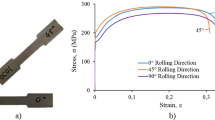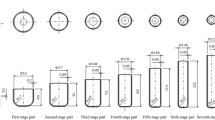Abstract
The limits of the processing window for deep drawing, collected in a deep drawing diagram, are affected by material behavior, process parameters and size effects. A size effect, more specific a density effect, explains the changes in forming behavior of foils with respect to the forming limit, denoted by the limiting drawing ratio. It is shown that it occurs in so called Tiffany structures. The changes in the tribology in deep drawing have an influence on the clamping limit of the processing window. The changes are induced by changes of the drawing speed. They can be explained by the lubricant pocket model only if one takes the temperature dependence of the viscosity of the lubricant into account.









Similar content being viewed by others
Abbreviations
- μ:
-
Coefficient of friction from Coulombs law
- μeff :
-
Effective coefficient of friction from numerical identification using the formula by Storoshew
- μff(p):
-
Coefficient of friction as function of contact pressure, given by the so called friction function
- μH :
-
Coefficient of friction for hydrodynamic contact
- μS :
-
Coefficient of friction for solid contact
- μT :
-
Total coefficient of friction
- A0 :
-
Macroscopic contact cross section area (mm2)
- AL :
-
Liquid contact area (mm2)
- AS :
-
Solid contact area (also: real contact area) (mm2)
- d:
-
Diameter (mm)
- dB,0 :
-
Initial blank diameter (mm)
- dp :
-
Punch diameter (mm)
- F:
-
Force (N)
- FB :
-
Blank holder force (N)
- FH :
-
Normal force transferred by hydraulic medium (N)
- FN :
-
(Total) normal force (N)
- FP :
-
Punch force (N)
- FS :
-
Normal force on solid contact (N)
- lp :
-
Punch travel distance during forming process (mm)
- p:
-
(Contact) pressure (N/mm²)
- pB :
-
Blank holder pressure (N/mm²)
- pB,0 :
-
Initial blank holder pressure (N/mm²)
- pL :
-
Lubricant pressure (N/mm²)
- pS :
-
Pressure of solid contact (N/mm²)
- r:
-
Radius (mm)
- rD :
-
Drawing radius (edge radius of drawing ring) (mm)
- rP :
-
Punch radius (radius between bottom and mantle) (mm)
- s0 :
-
Sheet thickness (mm)
- T:
-
Temperature (K)
- T0 :
-
Temperature at viscosity η0 (K)
- v:
-
Velocity (m/s)
- vP :
-
Punch speed (m/s)
- α:
-
Viscosity temperature index
- β:
-
Drawing ratio (ratio of blank diameter to punch diameter)
- βmax :
-
Limiting drawing ratio
- ΔdD :
-
Drawing clearance (mm)
- η:
-
Viscosity (m²/s)
- η0 :
-
Viscosity at temperature T0 (m²/s)
- ρ:
-
Density (g/cm³)
- φmax :
-
Maximum strain
References
Dahl W, Knopp R, Pawelski O (1993) Umformtechnik Plastomechanik und Werkstoffkunde (in German). Springer, Berlin, pp 158–173
Geiger M, Kleiner M, Eckstein R, Tieseler N, Engel U (2001) Microforming. CIRP Annal Manufact Technol 50(2):445–462
Geiger M, Engel U, Vollertsen F (1992) In situ ultrasonic measurement of the real contact area in bulk metal forming processes. CIRP Annal Manufact Technol 41(1):255–258
Goodwin GM (1968) Application of strain analysis to sheet metal forming problems in the press shop. SAE paper 680093
Grebe M, Feinle P (2004) Reibwertuntersuchungen an Motorölen im Mikrotribometer (in German) Tribologie-Fachtagung, Reibung, Schmierung und Verschleiß Göttingen
Grote K-H, Feldhusen J (2001) Dubbel Taschenbuch für den Maschinenbau (in German). Springer, Berlin, p E84
Hasek V, Lange K (1980) Forming-limit diagram and its applications in deep-drawing and stretch-forming processes (in German). Wirtsch Z Ind Fertig 70:577–580
Hol J, Cid Alfaro MV, de Rooij MB, Meinders T (2010) Multiscale fritction modeling for sheet metal forming. In: Felder E, Montmitonnet P (eds) 4th International conference on tribology in manufacturing process (ICTMP 2010). Transvalor Paris, pp 573–582
Hu Z, Vollertsen F (2004) A new friction test method. J Technol Plasticity 29(1–2):1–9
Hu Z, Vollertsen F (2010) Effect of size and velocity dependent friction in deep drawing on the process window. In: Felder E, Montmitonnet P (eds) Proceedings of the 4th International conference on tribology in manufacturing processes (ICTMP (2010)). Transvalor Paris, pp 583–592
Hu Z, Wielage H, Vollertsen F (2010) Effect of strain rate on the forming limit diagram of thin aluminum foil. In: Dohda K (ed) Proceedings of the International forum on micro manufacturing (IFMM’10). Nagoya Institute of Technology Nagoya (2010), pp 181–186
Hu Z, Wielage H, Vollertsen F (2011) Forming behavior of thin foils. In: Duflou JR, Clarke R, Merklein M, Micari F, Shirvani B, Kellens K (eds) 14th International conference on sheet metal (SheMet11). TransTech Publication, Zurich-Durnten (2011), pp 1008–1015
Janssen PJM, de Keijser ThH, Geers MGD (2006) An experimental assessment of grain size effects in the uniaxial straining of thin Al sheet with a few grains across the thickness. Mater Sci Eng A419:238–248
Justinger H, Hirt G (2007) Scaling effects in the miniaturisation of the deep drawing process. In: Vollertsen F, Yuan S (eds) International conference on new forming technologies (2nd ICNFT’07). BIAS-Verlag Bremen, pp 167–176
Justinger H, Hirt G (2007) Analysis of size effects in the miniturized deep drawing process. Key Eng Mater 344:791–798
Justinger H (2009) Experimentelle und numerische Untersuchung von Miniaturisierungs-einflüssen bei Umformprozessen am Beispiel Tiefziehen (in German). Shaker Verlag
Keeler SR, Backofen WA (1963) Plastic instability and fracture in sheets stretched over rigid punches. Trans ASM 56:25
Kim H, Han S, Yan Q, Altan T (2008) Evaluation of tool materials, coatings and lubricants in forming galvanized advanced high strength steels (AHSS). CIRP Annal Manufact Technol 57:299–304
Kim J, Hoffmann H, Golle M, Golle R (2009) Untersuchungen zum Werkstoffverhalten von sehr dünnen Kupferblechen (in German). In: Vollertsen F (ed) Größeneinflüsse bei Fertigungsprozessen. BIAS Bremen, pp 57–78
Merklein M, Kuppert A, Geiger M (2010) Time dependent determination of forming limit diagrams. CIRP Annal Macufact Technol 59(1):295–298
Pawelski O, Lueg W (1961) Versuche und Berechnungen über das Ziehen und Einstoßen von Rundstäben (in German). Stahl u. Eisen 81(25):1729–1739
Penazzi L, Yang G, Levaillant C, Le Floch A (1996) Assessment of thermal effect in the sheet metal forming process. 19th IDDRG Biennial Congress, pp 287–293
Pfestdorf M (1997) Funktionale 3D-Oberflächenkenngrößen in der Umformtechnik (in German). Meisenbach Verlag, Bamberg
Putz A (2006) Grundlegende Untersuchungen zur Erfassung der realen Vorspannung von armierten Kaltfließpresswerkzeugen mittels Ultraschall (in German). Meisenbach Verlag, Bamberg, p 85
Schulze Niehoff H, Vollertsen F (2007) Versatile microforming press. In: Vollertsen F, Yuan S (eds) International conference on new forming technologies (2nd ICNFT’07). BIAS-Verlag, Bremen, pp 167–176
Schulze Niehoff H (2008) Entwicklung einer hochdynamischen, zweifachwirkenden Mikroumformpresse (in German). BIAS-Verlag, Bremen
Schulze Niehoff H, Hu Z, Vollertsen F (2008) Einflüsse von Größeneffekten auf das Grenzziehverhältnis In: Steinhoff K, Kopp R (eds) Der Pawelski—Umformtechnik im Spannungsfeld zwischen Plastomechanik und Werkstofftechnik. Hrsg. GRIPS media GmbH Bad Harzburg, pp 207–215
Sobis T, Engel U, Geiger M (1992) A theoretical study of wear simulation in metal forming processes. J Mater Process Technol 34:233–240
Storoschew MW, Popow EA (1968) Grundlagen der Umformtechnik. VEB Verlag Technik, Berlin
Vollertsen F, Hu Z (2007) On the drawing limit in micro deep drawing. J Technol Plasticity 32(1/2):1–11
Vollertsen F (2008) Categories of size effects. Product Eng 2(4):377–383
Vollertsen F, Biermann D, Hansen HN, Jawahir IS, Kuzman K (2009) Size effects in manufacturing of metallic components. CIRP Annal Manufact Technol 58(2):566–587
Vollertsen F, Hu Z, Wielage H, Blaurock L (2010) Fracture limits of metal foils in micro forming. In: Hinduja S, Li L (eds) 36th International MATADOR conference. Springer, London, pp 49–52
Vollertsen F (2011) Size effects in micro forming. In: Duflou JR, Clarke R, Merklein M, Micari F, Shirvani B, Kellens K (eds) 14th International conference on sheet metal (SheMet11). TransTechPublication, Zurich-Durnten, pp 3–12
Wielage H (in print) Hochgeschwindigkeitsumformen durch laserinduzierte Schockwellen. Series Strahltechnik, BIAS, Bremen
Acknowledgments
The author is grateful for the financial support of the Deutsche Forschungsgemeinschaft (DFG) of the projects B1 and B3 of the Collaborative Research Center SFB 747, where the results were obtained. The author also thanks for support by Dipl.-Ing. S. Grünenwaldand Dr.-Ing. Z. Hu whilepreparingthismanuscript.
Author information
Authors and Affiliations
Corresponding author
Rights and permissions
About this article
Cite this article
Vollertsen, F. Effects on the deep drawing diagram in micro forming. Prod. Eng. Res. Devel. 6, 11–18 (2012). https://doi.org/10.1007/s11740-011-0355-5
Received:
Accepted:
Published:
Issue Date:
DOI: https://doi.org/10.1007/s11740-011-0355-5




